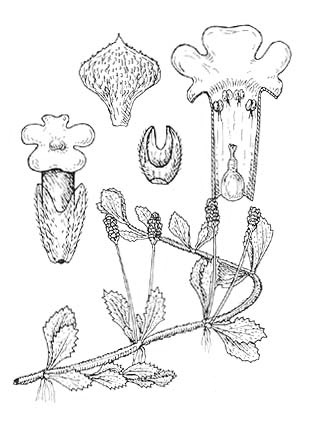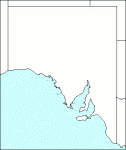Family: Verbenaceae
Phyla nodiflora
Citation:
Greene, Pittonia 4:46 (1899).
Synonymy: Verbena nodiflora L., Sp. Pl. 20 (1753); Lippia nodiflora (L.)Michaux, Fl. Bor. Am. 2:15 (1803); Zapania nodifiora (L.)Lam., Tabl. Encycl. 1, 59:t. 17, fig. 3 (1791).
Common name: Lippia, fog fruit.
Description:
Perennial creeping herb; stem much branched, mostly rooting at the nodes, usually 30-90 cm long, with slender procumbent or ascending flowering branches, hoary with closely appressed hairs or nearly glabrous; leaves obovate, spathulate or oblanceolate, sometimes elliptic or cuneiform, narrowed into a short petiole, more or less fleshy, 1-7.2 cm long, 0.4-2.5 cm wide, coarsely toothed above the middle, minutely puberulent or glabrous, the venation usually inconspicuous; petiole 1-8 mm long.
Peduncles axillary but only one to each pair of leaves, 1-11 cm long; spikes at first short and ovoid, and sometimes very small, at length cylindrical, dense, 1-2.5 cm long when mature, 6-9 mm diam., many-flowered; bracts closely imbricate, the leaves ovate-oblong, long- acuminate, the higher ones obovate, ovate-triangular above the cuneate base, acute, green or violet, more or less fringed or toothed at the end; flower-buds purple; calyx shorter than the bract, membranous, flat, deeply 2-cleft, slightly 2-keeled, c. 1.5 mm long; corolla purple or pink to white; tube c. 2 mm long; limb at first white, afterwards lilac with a darker eye, 2-2.5 mm across, the lower lip twice as long as the upper one and about half as long as the tube.
Fruit c. 2 mm long, splitting at maturity into 2 mericarps, each 1-seeded.

| Flowering branch, flower, opened flower, bract and two lipped calyx.
|
Image source: fig. 544B in Jessop J.P. & Toelken H.R. (Ed.) 1986. Flora of South Australia (4th edn).
|
Published illustration:
Small (1933) Manual of the south-eastern flora, p. 1140; Moldenke (1973) Ann. Miss. Bot. Gard. 60:fig. 3; Cunningham et al. (1982) Plants of western New South Wales, p. 568.
|
|
Distribution:
|
Widely distributed throughout subtropical and tropical parts of the world. Found in moist or wet soil of fields, lawns, hillsides, riverbed edges or ponds, and thickets.
W.Aust.; N.T.; Qld; N.S.W.
|
Conservation status:
naturalised
Flowering time: mainly Oct. — April.
|

SA Distribution Map based
on current data relating to
specimens held in the
State Herbarium of South Australia
|
Biology:
No text
Author:
Not yet available
|

